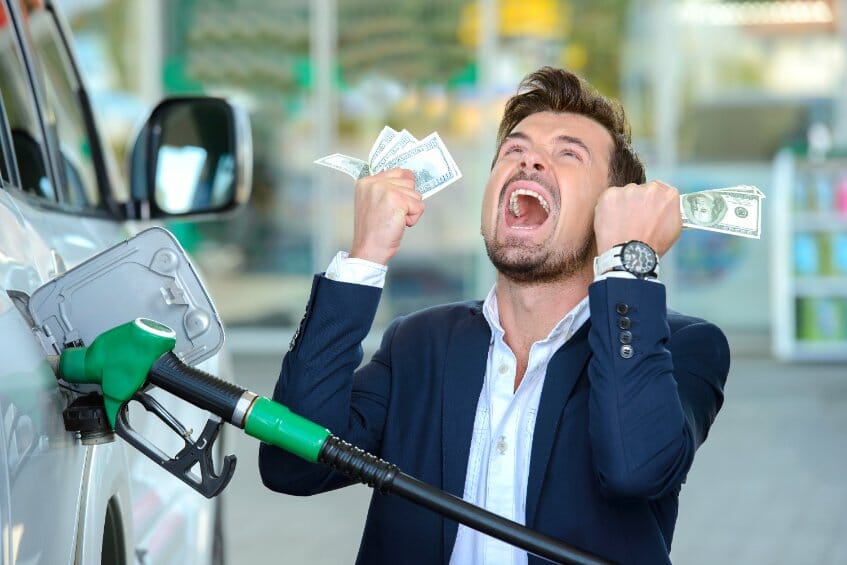If you’re at the gas station filling up (or let’s be honest, many of us are just putting enough fuel in the tank to get us to our destination) then you’re likely feeling shocked and frustrated by the price at the pump. With fuel prices nearing or surpassing $5 a gallon, we’re all feeling the pain and looking for ways to save money on gas.
As the price of gas continues to soar and your summer road trips are underway, you can use the 10 tips below to help you save money on gas and save an average of 20 percent on fuel costs. Saving money at the gas pump means more money in your pocket. Keep all or some of these tips in your mental glovebox and don’t forget to share them with your friends and family, so they can save too!
READ ALSO: How to maximize mileage as gas prices near record high
Fuel-up at sun-up or sundown. The best time to put gas in your car is during the coolest time of the day, so fuel-up early in the morning before the sun rises or late in the evening, well after the sun has set. Why? Gasoline expands with an increase in temperature. Since gas pumps measure volumes of gasoline, not densities of fuel concentration, you are charged according to the volume of measurement. You’ll get less gasoline for the volume when you fuel-up mid-day.
Use your cruise. When you’re on the highway or whenever it’s appropriate, be sure to use your cruise control. When you aren’t using your cruise control, your foot is constantly laying on and off the pedal as you react to traffic around you, forcing more fuel into the engine unnecessarily. Using your cruise control can smooth out the driver’s accelerator input by preventing this type of “nervous surging” resulting in a 14 percent fuel savings!
Minimize air conditioning use. I realize this suggestion may be nearly impossible as we’re in the middle of our triple digit summer temperatures, but here’s the bad news- your car’s air conditioner can reduce your fuel economy by 10 to 20 percent! Using your air conditioning system increases its fuel consumption more than any other auxiliary feature. Just by running your air conditioning, it can take up to 50 percent of your engine’s horsepower. It puts an extra load on your engine and the more load on your engine, the less miles you’ll get per gallon. The good news? Come late September, this won’t even be an issue!
Don’t stay idle. When you’re waiting for your food in a drive-thru line, it’s better to turn your car off than leave it running idle. Anytime you must stop for more than 30 seconds, don’t idle your car. The engine is more fuel efficient if you turn it off and restart it. Similarly, when starting your car, don’t idle it for more than 30 seconds, even in colder weather. Today’s cars are designed to be driven almost immediately.
Drive moderately. Another reason to avoid aggressive driving is that it can save you up to 37 percent more fuel efficiency! For all the lead foot drivers out there – now you have a monetary reason to ease-up on the accelerator (and your passengers may thank you at the same time)! I also encourage you to slow down, not just for traveling safety, but because your speed affects fuel efficiency. Traveling at 55 miles per hour helps save money on gas and gives you up to 20 percent better mileage, when compared to speed limits of 65 and 70 miles per hour.
Check air filters. It’s important to check and replace your car’s air filters regularly, even if you are working remotely and not driving as much as you used to. You don’t want to run into the same situation my service team did when they discovered a family of rats had made a cozy home inside a customer’s car who has been working from home. By the way, replacing clogged air filters can increase your gas mileage by up to 10 percent!
Use correct fuel grade. Check your owner’s manual to confirm which grade of gasoline is the most effective for your car. Often, using a higher octane (premium) gas that the manufacturer recommends, offers no benefit and has nothing to do with fuel economy.
Care for your tires. Your tires are an important safety system that also contributes to fuel efficiency. Under-inflated tires are a huge factor in fuel savings, so make sure your tire pressure is at the proper level. A National Highway Traffic Safety Administration study found that more than 25 percent of passenger vehicles on the road have at least one tire that’s under-inflated by six psi or more, which can equate to a 20 percent decrease in fuel economy because of tire wear and substantially higher tire failure rate. I always recommend taking a quick walk around your car to check for visibly low or flat tires before you drive. Another tip for tire care- keep your wheels aligned, so you get better mileage (and longer tire life too!).
Do NOT top off. It’s a myth that you should top off your tank after the pump shuts off. In fact, it can actually be detrimental to do so because the fuel can get into your emissions system and damage its components. When the pump shuts off, do not continue to pump gasoline into your tank.
Drain the gas hose. While you should not top off your tank after the pump has automatically shut off, you can lift the gas pump hose vertically (after the pump has stopped) to drain the gas hose. This little trick can produce up to two Dixie cups (three ounces) of fuel! You’ve already paid for it, so you might as well take it with you!
Kevin Naylor is a Peoria resident and Service Director at Larry H. Miller Hyundai Peoria. He saves $15 at the pump each week by following his own tips.




